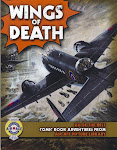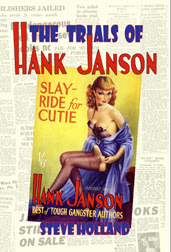 The Best of Roy of the Rovers: The 1980s is a bit of a misnomer for a book that reprints a straight two-year run of stories. Ironically, it is one of the strengths of the Roy of the Rovers strip that is proving to be a pain from a marketing point of view—the Roy strip was a soap-opera with a series of storylines that would dramatically (often very dramatically) reboot the strip. You cannot easily choose a random group of episodes as representative because overarching plots would sometimes take a whole season to unfold, come to fruition and reach some sort of resolution; the resolution could very well involve the demise of major characters in the best soap-opera tradition of, say, EastEnders. Unlike EastEnders, however (and, it must be said, American comics), dead characters were never brought back to life in desperate grabs for ratings or sales.
The Best of Roy of the Rovers: The 1980s is a bit of a misnomer for a book that reprints a straight two-year run of stories. Ironically, it is one of the strengths of the Roy of the Rovers strip that is proving to be a pain from a marketing point of view—the Roy strip was a soap-opera with a series of storylines that would dramatically (often very dramatically) reboot the strip. You cannot easily choose a random group of episodes as representative because overarching plots would sometimes take a whole season to unfold, come to fruition and reach some sort of resolution; the resolution could very well involve the demise of major characters in the best soap-opera tradition of, say, EastEnders. Unlike EastEnders, however (and, it must be said, American comics), dead characters were never brought back to life in desperate grabs for ratings or sales.The strips here originally appeared in the weekly Roy of the Rovers between September 1980 and June 1982, taking in the whole of the 1980-81 and 1981-82 seasons and one of the most heart-stopping of all Roy stories. On 12 December 1981, Roy was shot by a mysterious gunman. Inspired by the 'who shot JR' publicity that had surrounded Dallas, the identity of the mystery shooter was kept secret for months.
The book opens with an injury-depleted Melchester Rovers struggling to find form as the season opens. There's plenty of action on the pitch and, because a match can last for a month or more, every game has something vital to the plot, whether it's the form of old players, the arrival of a new team-mate or touble at the top or the bottom of the league table that makes it crucial that Rovers win.
 But the action wasn't always on the playing field: there was as much drama off the pitch as team-mates fall out with each other and—as in this volume—Roy has as many problems at home as he does at Melchester Stadium. Roy was one of the few characters in comics aimed at boys where Roy had a home life: he's married, to Penny, and has twin children, and author Tom Tully made sure that Penny was sometimes at the heart of a storyline long before WAGS took on a celebrity all of their own.
But the action wasn't always on the playing field: there was as much drama off the pitch as team-mates fall out with each other and—as in this volume—Roy has as many problems at home as he does at Melchester Stadium. Roy was one of the few characters in comics aimed at boys where Roy had a home life: he's married, to Penny, and has twin children, and author Tom Tully made sure that Penny was sometimes at the heart of a storyline long before WAGS took on a celebrity all of their own.Roy's cousin, Arnie Meckiff, is another off-field troublemaker, as is Elton Blake, an actor who is to play Roy in a TV show... the list of people unhappy with Roy Race begins to grow as the new season kicks off, leading to the shocking sight of Roy being shot. Hospitalised and in a coma, Melchester Rovers' directors turn to one of the biggest names in football to take over the team—former England manager Sir Alf Ramsey.
And here we have another soap-opera staple: the strips are played out in a bizarre version of real time where a 90-minute football match can last four weeks but a season lasts a season and real world events are referred to (the Royal Wedding of Prince Charles and Diana Spencer, for instance). Real people were part and parcel of the storylines, making the standard "any resemblance to actual persons is entirely coincidental" notice at the front of the book completely redundant—star guests were always popping up to Melchester to visit the team, some playing key roles in various plots.
Keeping all these elements bubbling along season after season took as much skill as Roy showed on the pitch, so all praise goes to Tom Tully, one of the finest writers British comics ever had. His was the hand behind the twisting plotlines and constant Greek chorus of terrace commentary that kept Roy at the top of the comics' league for twenty years. For eleven of those years he worked with artist David Sque who saw Roy through his mid-1970s to mid-1980s fluffy haircut era.
 As for the book itself, Titan have published it in a flexiback format, with over 200 full-colour pages for an astonishing £9.99. They clearly have a lot of faith in Roy to sell as further volumes are already lined up (the Bumper Book for August and the first Archives volume in a bit of flux, although possibly as early as December). The colours look a little washy, although I seem to remember that the printing on the original comic didn't really pick up until 1986.
As for the book itself, Titan have published it in a flexiback format, with over 200 full-colour pages for an astonishing £9.99. They clearly have a lot of faith in Roy to sell as further volumes are already lined up (the Bumper Book for August and the first Archives volume in a bit of flux, although possibly as early as December). The colours look a little washy, although I seem to remember that the printing on the original comic didn't really pick up until 1986.I'm unashamedly a fan of this era of Roy's career and can't wait to relive the next few seasons as the 1980s progress: Roy's departure from Melchester to Melboro should make the next volume, followed by one of the most devestating storylines that ever hit the Rovers when the team were caught in the middle of a revolution in Basran... there's still plenty of action to come as Roy's
career progresses.
The Best of Roy of the Rovers: The 1980s. Titan Books (ISBN 978-1845769482), 13 June 2008, 208pp, £9.99.























































No comments:
Post a Comment